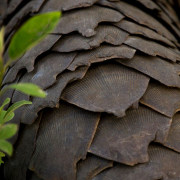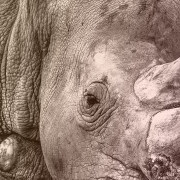|
Getting your Trinity Audio player ready...
|
Image: Wilson Lau, TRAFFIC
A humble marine mollusc, Haliotis midae, has been the inadvertent cause of one of South Africa’s biggest poaching/smuggling challenges. The largest abalone in South Africa, it is known locally as perlemoen, from the Dutch meaning ‘mother of pearl’. Occurring naturally along the South African coastline, perlemoen is nothing more than a giant, flat sea snail but its desirability and high market value is such that a whole industry of illegal harvesting and trade has developed around it.
In our series on corruption in wildlife, forest and fisheries crime, we presented an overview in part 1, and we discussed the link between wildlife crime and corruption in part 2. In part 3 we explored the link between wildlife crime and other crime, and in this instalment we continue the convergence theme by highlighting a recently released case study by the Wildlife justice Commission (WJC) on South Africa’s long-standing perlemoen smuggling trade. In the final part 5, we will focus on the money laundering methods and routes used to spirit away the proceeds of these crimes.
The steady growth of illegal wildlife trafficking over the past two decades has made many people wealthy. According to a 2016 joint study by Interpol and the UN Environment Programme (UNEP), titled The Rise of Environmental Crime, environmental crime grows at a rate of between 5 % and 7 % per year. It is extremely lucrative, with a relatively low risk of detection and if detected, is likely to incur lower criminal penalties. Much of this growth has been enabled by corruption, as we saw in part 2.
Wildlife crime often happens alongside other types of organised crime, because the routes, methods, technology and corrupt allies can be used for a variety of ill-gotten goods. Authorities have noted, as far back as 2015, the overlap of corruption, human trafficking, drug trafficking and maritime piracy with illegal fisheries, or kidnapping, illegal firearms trading and robbery, extortion and murder, cyber-crime and money laundering in relation to trade in tiger parts and tiger products.
Sought-after delicacy
Currently, perlemoen may only be commercially farmed and harvested. The South African Sustainable Seafood Initiative lists such perlemoen on its green list of seafood that is acceptable to eat because it has been prepared sustainably, but says that the hand-caught variety is a no-no. Local fisherman, however, and recreational gatherers have taken their quotas for decades – whether legally or not, their small catches have posed no great trouble – but the insatiable demand from the Far East is endangering the existing stocks, to the point where it may soon become unsustainable for the legal industry.
Furthermore, it’s organised crime in the form of largely Chinese syndicates doing the damage, according to a new study titled Convergence of wildlife crime with other forms of organised crime, released by the WJC in May 2021. Perlemoen smuggling is one of 12 case studies in the report, which highlights the convergence of the ongoing seafood stealing with trade in illicit drugs. This makes for a dangerous mix.
These syndicates work with accomplices in South Africa, causing the latter to risk their health, freedom, reputations – and lives – for a payment that’s a fraction of what an Asian consumer will pay. In May 2021 two men were nabbed for transporting nearly 24 000 units of perlemoen, valued at R9.9-million. A gang caught in June had eight bags containing 1 689 units of abalone, with an estimated street value of R1.4-million. Another group arrested in July were transporting 920 units valued at over R800 000. All of them face hefty fines or jail time – but their exploits are just a drop in the ocean.
The sea creatures are easy prey for local gangs operating in fishing settlements close to known poaching sites, says WJC. They supply the Chinese criminal groups, and the abalone is dried and transported in trucks across the border into Namibia, Zimbabwe, or Mozambique. From there, it is exported to Hong Kong. Dried abalone, therefore, is almost certain to be illegally sourced.
“… the high demand in Asian markets is … drawing local fishing communities into the criminal underworld,” WJC says. “More than 96-million individual abalone are estimated to have been poached in the 10 years from 2006-2016, with 90% of them sent to Hong Kong SAR.”
All of the above-mentioned abalone are believed to be H. midae.
Between 2012 and 2015, a former abalone poacher says, a third of Hong Kong’s dried abalone imports came from South Africa, while a similar quantity was laundered via Mozambique, Zimbabwe, Namibia, and Zambia – all countries with no wild abalone stocks. “This means that nearly 65% of all the dried abalone entering Hong Kong was South African in origin. Of this, an estimated 65% stemmed from the black market, making it the world’s biggest conduit of dried abalone to China.”
TRAFFIC, an organisation that monitors wildlife trade, says in a 2018 survey of abalone trade and consumption in Hong Kong, that “90% of Hong Kong consumers surveyed had eaten abalone at least once in the past year”. But only 46% of those consumers surveyed were aware of abalone poaching in South Africa, although some 80% of dried seafood importers surveyed were aware of the illegal activities in the abalone trade.
None of that matters to the people who are prepared to pay for the delicacy, or their suppliers who earn good money from the trade. South African perlemoen commands a high price on the market – in 2018 a single tray of South African abalone could go for more than R60 000 – second only to Japanese varieties.
The problem, TRAFFIC reports, is that there are no laws in Hong Kong protecting the import of South African abalone. “Once poached abalone arrives in Hong Kong, under the current legislation, it can be openly traded and sold in markets alongside legally sourced abalone.”
So there is no course of legal or enforcement action available to block the sale of poached abalone once the product reaches the market, the organisation says. This could be resolved with a listing in the CITES appendix III, which regulates the international trade of species listed therein.
Surprisingly, perlemoen has no CITES listing, which gives criminals even more of a free ride. It was at one time listed in Appendix III, and in the National Environmental Management: Biodiversity Act, but was removed from both instruments because of pressure from the fishing industry.
Drugs and perlemoen
Shipments of illegal abalone are reportedly often exchanged for drugs such as methamphetamine (tik) or its chemical precursors, says WJC. This embeds the trade within South Africa’s drug economy, and in fact, perlemoen trafficking has been a significant driver of the increase in methaqualone (white pipe) and methamphetamine to South Africa.
“Although this abalone-for-drugs criminal trade has been widely reported in South Africa by multiple sources, there is a dearth of specific cases of seizures or arrests involving both commodities, indicating that this convergence may not yet be effectively targeted by law enforcement authorities,” WJC notes.
As expected, corruption is also known to be closely linked to South Africa’s abalone black market. WJC cites a case from 2018, in which nine fisheries inspectors were arrested for colluding with perlemoen poachers, going as far as to escort the illegal shipments. Another two top fisheries officials were accused of separate scandals including fraudulent tenders and sabotaging an investigation into an abalone syndicate.
To combat the criminal perlemoen trade, anti-corruption practises must continue, says WJC. There is a need for “a systemic approach to identify and mitigate corruption vulnerabilities in this sector”.
Furthermore, organised crime group mapping would serve to help identify those criminal networks who are involved in a variety of different crimes. This, says WJC, would “enable law enforcement to focus resources more efficiently on targeting those groups posing a higher criminal threat”.
Another suggestion is to regulate the selling and marketing of abalone, so that only legal, recognised channels would be able to receive the delicacy. Furthermore, bringing coastal communities legally into the industry through abalone ranching – restocking abalone in the wild by distributing larvae into the sea – would negate the need for illegality. There is a snag in that abalone typically takes around seven years to reach maturity.
Equally important, local society and economy needs a thorough overhaul that would bring equality and opportunities to all South Africans. “We need a society where people feel invested in the rule of law, not alienated by it. And we need more effective law enforcement that shuts down supply lines instead of criminalising the working poor,” says Western Cape journalist Kimon de Greef, who has investigated and written extensively on the perlemoen industry.







